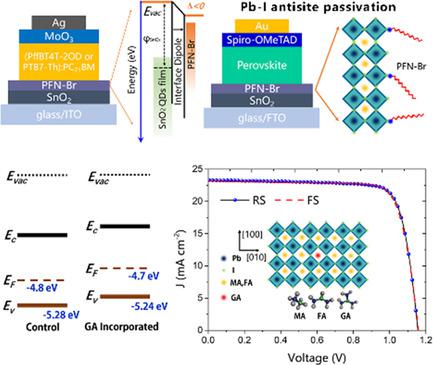Our official English website, www.x-mol.net, welcomes your feedback! (Note: you will need to create a separate account there.)
Reconfiguration of Interfacial and Bulk Energy Band Structure for High‐Performance Organic and Thermal–Stability Enhanced Perovskite Solar Cells
Solar RRL ( IF 7.9 ) Pub Date : 2019-12-10 , DOI: 10.1002/solr.201900482 Yaxiong Guo 1, 2 , Hongwei Lei 1 , Changlei Wang 3 , Junjie Ma 2 , Cong Chen 2 , Xiaolu Zheng 2 , Guang Yang 2 , Liangbin Xiong 4 , Zuojun Tan 1
Solar RRL ( IF 7.9 ) Pub Date : 2019-12-10 , DOI: 10.1002/solr.201900482 Yaxiong Guo 1, 2 , Hongwei Lei 1 , Changlei Wang 3 , Junjie Ma 2 , Cong Chen 2 , Xiaolu Zheng 2 , Guang Yang 2 , Liangbin Xiong 4 , Zuojun Tan 1
Affiliation

|
Tin oxide (SnO2) offers its advantages in widespread applications that require efficient carrier transport. However, the usages of SnO2 in organic solar cells are hindered because of dangling bonds on the surface of SnO2. Herein, PFN‐Br as an interfacial layer to tailor the work function of SnO2 is adopted, making it an ideal candidate for interfacial material in organic electronics. Meanwhile, such an efficient SnO2/PFN‐Br electron transport layer (ETL) can also be applied to perovskite devices and achieve competitive efficiency. To eliminate current–voltage hysteresis and improve poor thermodynamic stability of perovskite solar cells (PSCs), 5 mol% of guanidinium iodide (GAI) into the (MA)x(FA)1 − xPbI3 precursor solution is incorporated, enabling the formation of triple‐cation perovskite films with excellent optoelectronic quality and stability. The combination of an SnO2/PFN‐Br ETL and GAI doping strategy finally delivers power conversion efficiencies over 21% and negligible current–voltage hysteresis in planar PSCs. These improvements arise from the strong hydrogen bonding caused by the incorporation of GA+. It can stiffen the inorganic Pb–I lattice of the unit cell and restrain the formation of iodine vacancies defects. Moreover, the strong hydrogen bonding can immobilize iodide ion and thus enhance the thermal stability of the corresponding device.
中文翻译:

高性能和热稳定性增强的钙钛矿太阳能电池界面能和本体能带结构的重构
氧化锡(SnO 2)在要求有效载流子传输的广泛应用中具有优势。然而,SnO的用法2在有机太阳能电池中,因为SnO的表面上的悬挂键的受阻2。在此,采用PFN-Br作为界面层来调整SnO 2的功函数,使其成为有机电子中界面材料的理想选择。同时,这种高效的SnO 2 / PFN-Br电子传输层(ETL)也可以应用于钙钛矿型器件并获得具有竞争力的效率。为消除钙钛矿型太阳能电池(PSC)的电流电压滞后现象并改善其差的热力学稳定性,将5 mol%的碘化胍(GAI)注入(MA)x(FA)1- x PbI 3前驱体溶液被掺入,可以形成具有优异的光电质量和稳定性的三阳离子钙钛矿薄膜。SnO 2 / PFN-Br ETL和GAI掺杂策略的结合最终在平面PSC中提供了超过21%的功率转换效率和可忽略的电流-电压滞后。这些改进是由于掺入GA +引起的强氢键结合而产生的。它可以使晶胞的无机Pb–I晶格变硬,并抑制碘空位缺陷的形成。此外,强的氢键结合可以固定碘离子,从而增强相应器件的热稳定性。
更新日期:2019-12-10
中文翻译:

高性能和热稳定性增强的钙钛矿太阳能电池界面能和本体能带结构的重构
氧化锡(SnO 2)在要求有效载流子传输的广泛应用中具有优势。然而,SnO的用法2在有机太阳能电池中,因为SnO的表面上的悬挂键的受阻2。在此,采用PFN-Br作为界面层来调整SnO 2的功函数,使其成为有机电子中界面材料的理想选择。同时,这种高效的SnO 2 / PFN-Br电子传输层(ETL)也可以应用于钙钛矿型器件并获得具有竞争力的效率。为消除钙钛矿型太阳能电池(PSC)的电流电压滞后现象并改善其差的热力学稳定性,将5 mol%的碘化胍(GAI)注入(MA)x(FA)1- x PbI 3前驱体溶液被掺入,可以形成具有优异的光电质量和稳定性的三阳离子钙钛矿薄膜。SnO 2 / PFN-Br ETL和GAI掺杂策略的结合最终在平面PSC中提供了超过21%的功率转换效率和可忽略的电流-电压滞后。这些改进是由于掺入GA +引起的强氢键结合而产生的。它可以使晶胞的无机Pb–I晶格变硬,并抑制碘空位缺陷的形成。此外,强的氢键结合可以固定碘离子,从而增强相应器件的热稳定性。


























 京公网安备 11010802027423号
京公网安备 11010802027423号